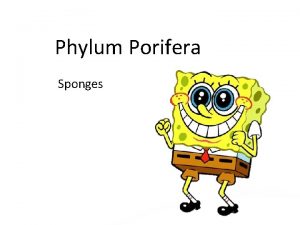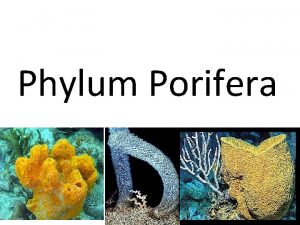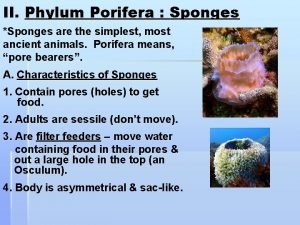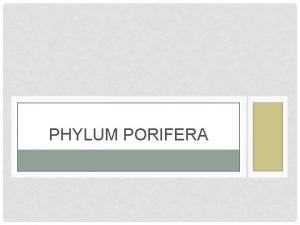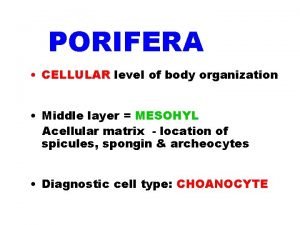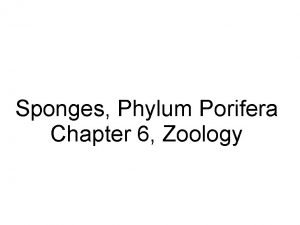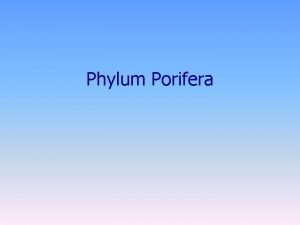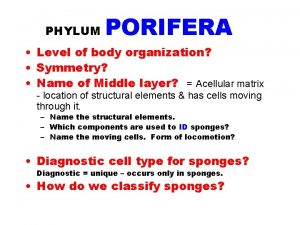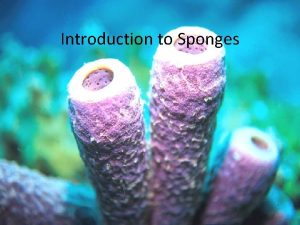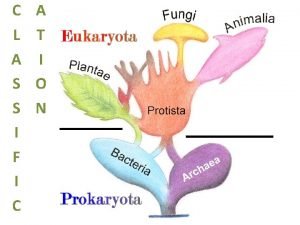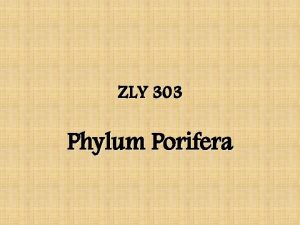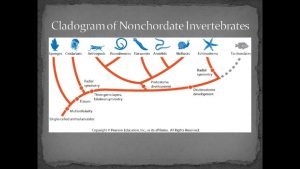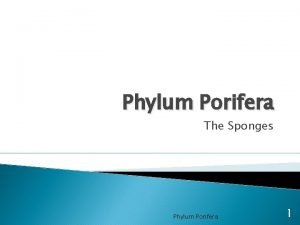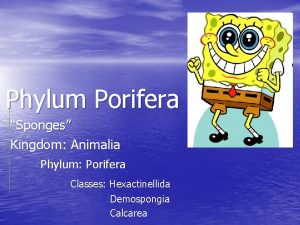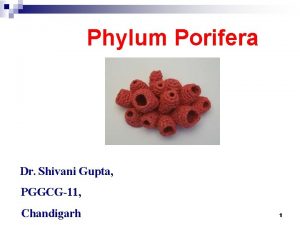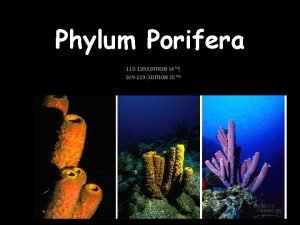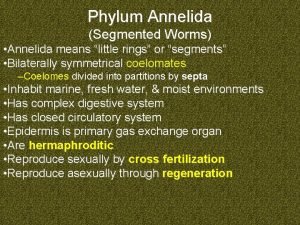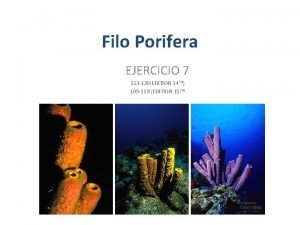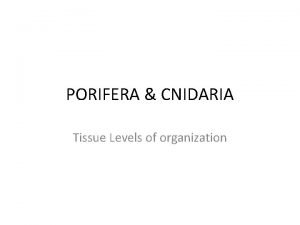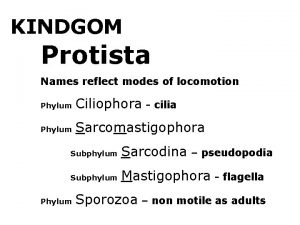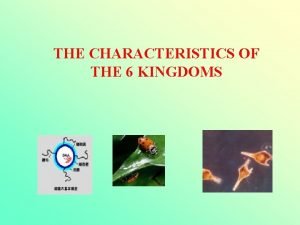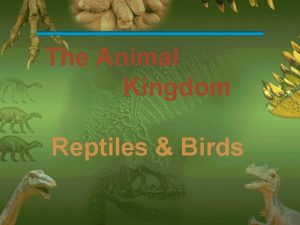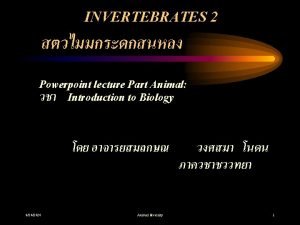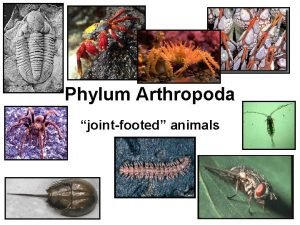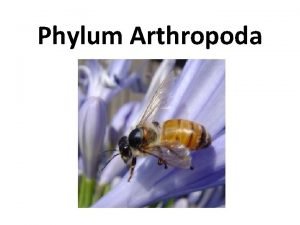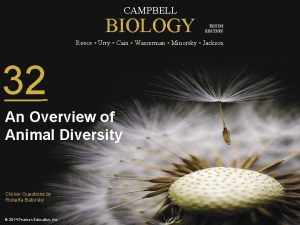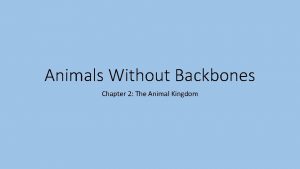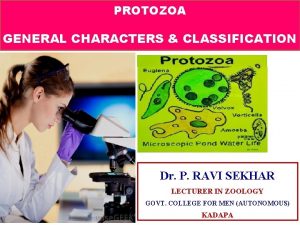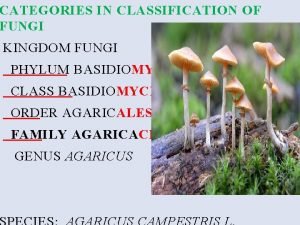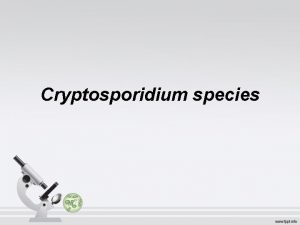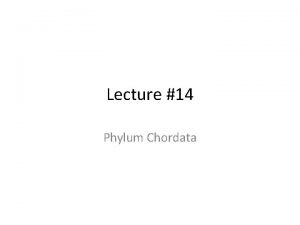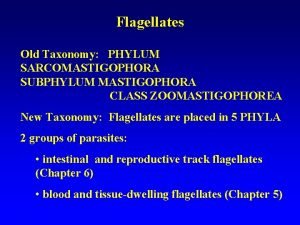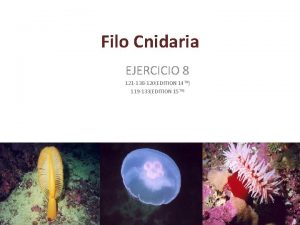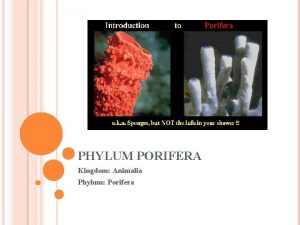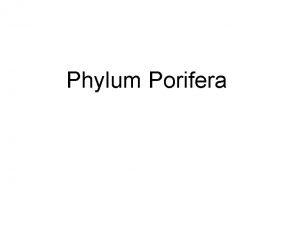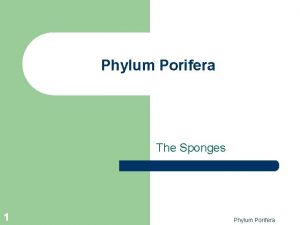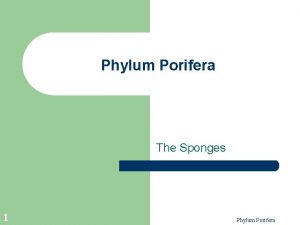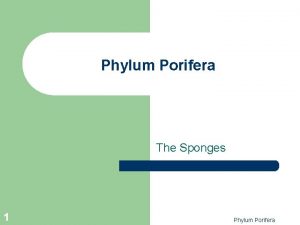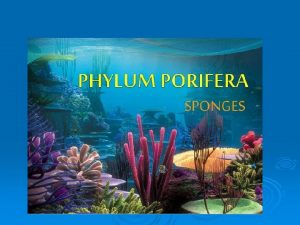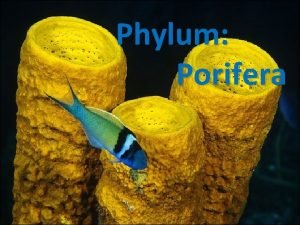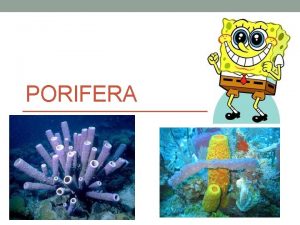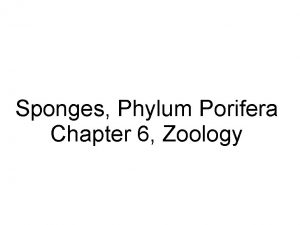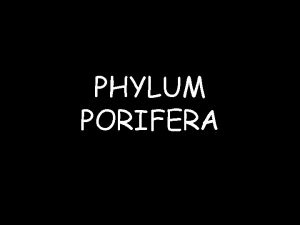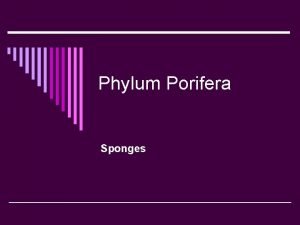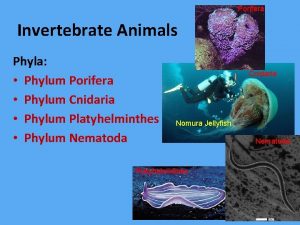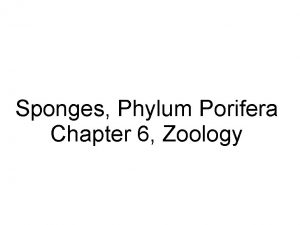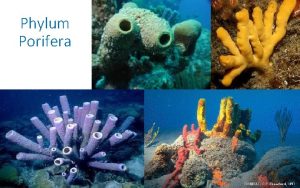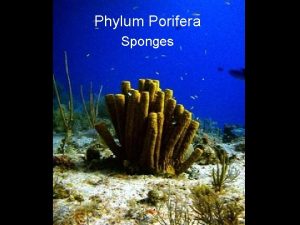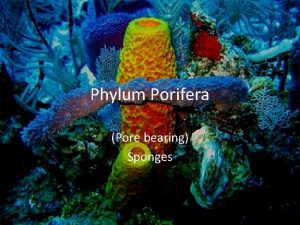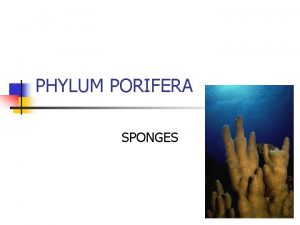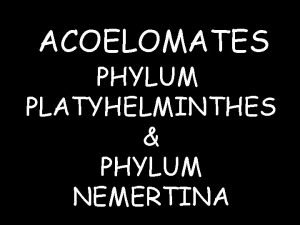CHAPTER2 PORIFERA Animal Classification Porifera The phylum Porifera








































- Slides: 40

CHAPTER-2 PORIFERA

Animal Classification


Porifera Ø The phylum Porifera (the sponges) includes about 5000 species almost all of which are marine (there about 150 freshwater species, members of the family Spongillidae). Ø Sponges occur worldwide at all latitudes from the intertidal zone to the deep sea. Ø Range in size from a few millimeters to 2 meters across. Ø Porifera means “pore-bearing” and refers to the numerous pores and channels that permeate a sponge’s body.

Yellow tube sponge Barrel sponge

Porifera Ø Sponges are the simplest multi-cellular organisms, but they lack the germ layers of more complex metazoans. l l Have a cellular level of organization lacking true tissues and organs. Body is a mass of cells imbedded in a gelatinous matrix (mesohyl) which is supported by a framework of spicules, as well as collagen and spongin fibers.

Glass sponge spicules

6. 8 Spicules form the stiffening skeletal structure of the sponge and may be made of calcium carbonate, silica or spongin [collagen].

Porifera feeding Ø Sponges are sessile (they don’t move) and depend on water movement to bring in food and oxygen and remove wastes. Ø Sponges generate their own flow of water having a unique water current system. Ø Water enters through many small pores called ostia and exits through fewer, larger oscula.

Oscula


Porifera feeding Ø Openings are connected by a series of canals, which are lined by choanocytes (the flagellated collar cells) that maintain the current and filter out food particles. Choanocytes

Porifera feeding Ø The choanocyte’s collar consists of microvilli joined together by delicate microfibrils, which filter out tiny food particles. Ø The beating of the flagellum draws water through the collar and out the top. Ø Particles too big to pass through the collar get trapped in mucus and slide down the collar to the base where they are phagocytized.


Porifera feeding Ø Sponges can filter enormous volumes of water as much as 20, 000 times the volume of the sponge in 24 hours. Ø Sponges mostly consume bacteria and may filter as much as 90% of those passing through.

Carnivorous sponges Ø A few sponges, however, capture small prey, such as crustaceans. Ø Members of the family Cladorhizidae capture their prey using spicules that act like velcro to hold the prey. Cells then surround and digest the prey extracellularly.

Porifera feeding Ø Some sponges also supplement their filter feeding by hosting symbionts such as green algae, dinoflagellates or cyanobacteria that provide nutrients to the sponge. Ø Corals (which are Cnidarians not sponges) similarly have symbiotic algae that live with them.

Types of cells in Porifera Ø Sponge cells occur scattered through a gelatinous matrix called mesohyl. Ø Spicules are distributed through the mesohyl as are several different specialized cells types.

Sponge cell types Ø Archaeocytes: move around within the mesohyl. They are ameboid in appearance and carry out several tasks. l l l Phagocytize particles and receive particles for digestion from choanocytes. Can differentiate into other specialized cell types. Secrete structural components. Specialized archaeocytes called sclerocytes, spongocytes and collenocytes secrete respectively spicules, spongin and collagen.

Sponge cell types Ø Choanocytes: (collar cells) engage in filter feeding. One end is imbedded in mesohyl and the other end protrudes. Ø The protruding end of the choanocyte has a flagellum that moves water through a mesh-like collar where small particles are trapped.

Sponge cell types Ø Porocytes: These are tubular cells that in the simplest type of sponge (asconoid sponges) form tubes through the wall of the sponge and allow water to flow into the central chamber.

Sponge cell types Ø Pinacocytes: Layers of pinacocytes form a flat, thin epithelium-like layer (unlike true epithelium [a tissue] the individual cells are not joined by bands of extracellular proteins). Ø Pinacocytes cover exterior and some interior surfaces. Ø Pinacocytes have some ability to contract and some arranged in bands around pores and use to regulate the flow of water in and out of the sponge.

Canal systems Ø Most sponges have one of three types of canal system: l l l Asconoid Syconoid Leuconoid Ø These systems differ from in each other in the increasing complexity.

Canal systems: asconoid Ø Asconoid is the simplest system. Water enters through pores into a single large central cavity (the spongocoel) which is lined with choanocytes. Ø There is a single large osculum.

Fig 6. 3 a

Canal systems: syconoid Ø In syconoid canal systems there is still a single spongocoel and osculum, but the lining of the spongocoel is folded back to make radial canals lined with choanocytes.

6. 3 b 6. 5

Canal systems: leuconoid Leuconoid organization is most complex and permits an increase in sponge size. Ø Most leuconoids form large masses with numerous oscula. Ø Clusters of choanocyte-lined chambers receive water from narrow incurrent canals and drive water into excurrent canals that eventually reach the osculum. There is no spongocoel. Ø

6. 3 c

Canal systems Ø The different grades of sponge canal complexity do not imply an evolutionary sequence as the leuconoid form has developed independently numerous times within different classes of sponges. Ø The leuconoid plan offers the significant advantage of increasing the proportion of flagellated cells relative to total sponge volume.

Sponge reproduction Ø Sponges reproduce both sexually and asexually. Ø Most sexually reproducing species are hermaphrodites (individuals produce both male and female gametes at different times). Ø Sperm are shed into the water and taken up by other sponges. Individuals with eggs use special cells called archaeocytes to transport sperm to the eggs.

Sponge reproduction Ø Zygotes develop into ciliated larvae that are released into the water and eventually settle and develop into a sponge. Ø Asexual reproduction is either by budding or more commonly the production of gemmules which are clusters of cells surrounded by a protective coat.

Gemmule

Groups of sponges Ø There are three classes of sponges: l l l Class Calcarea Class Hexactinellida Class Demospongiae






 Examples of sponges invertebrates
Examples of sponges invertebrates Sponges body plan
Sponges body plan Ascon sycon leucon
Ascon sycon leucon Invertebrates sponges characteristics
Invertebrates sponges characteristics Economic importance of sponges
Economic importance of sponges Collar cell
Collar cell Level of organization of porifera
Level of organization of porifera Sponge physiology
Sponge physiology Characteristics porifera
Characteristics porifera Phylum porifera type of symmetry
Phylum porifera type of symmetry Spongoceol
Spongoceol Features of porifera
Features of porifera Morski sundjer
Morski sundjer Phylum porifera nervous system
Phylum porifera nervous system Gambar tubuh porifera
Gambar tubuh porifera Spongocoel adalah
Spongocoel adalah Phylum porifera
Phylum porifera Euplectella
Euplectella Annelus means small ring
Annelus means small ring Phylum porifera
Phylum porifera Cnidaria organization level
Cnidaria organization level Phylum
Phylum Six animal kingdoms
Six animal kingdoms Animal kingdom phylum chordata
Animal kingdom phylum chordata Phylum
Phylum Similarities
Similarities Largest animal phylum
Largest animal phylum Which animal phylum has greater complexity than urochordata
Which animal phylum has greater complexity than urochordata Classification of porifera pdf
Classification of porifera pdf Animals without legs
Animals without legs Class genus species
Class genus species Phytoflagellata
Phytoflagellata Phylum protozoa classification
Phylum protozoa classification Fungi phylum characteristics
Fungi phylum characteristics Phylum platyhelminthes examples
Phylum platyhelminthes examples Phylum apicomplexa classification
Phylum apicomplexa classification What is phylum chordata
What is phylum chordata Trichomonas vaginalis taxonomy
Trichomonas vaginalis taxonomy What are cnidocytes
What are cnidocytes Horse taxonomy domain
Horse taxonomy domain Animal cell and plant cell venn diagram
Animal cell and plant cell venn diagram

